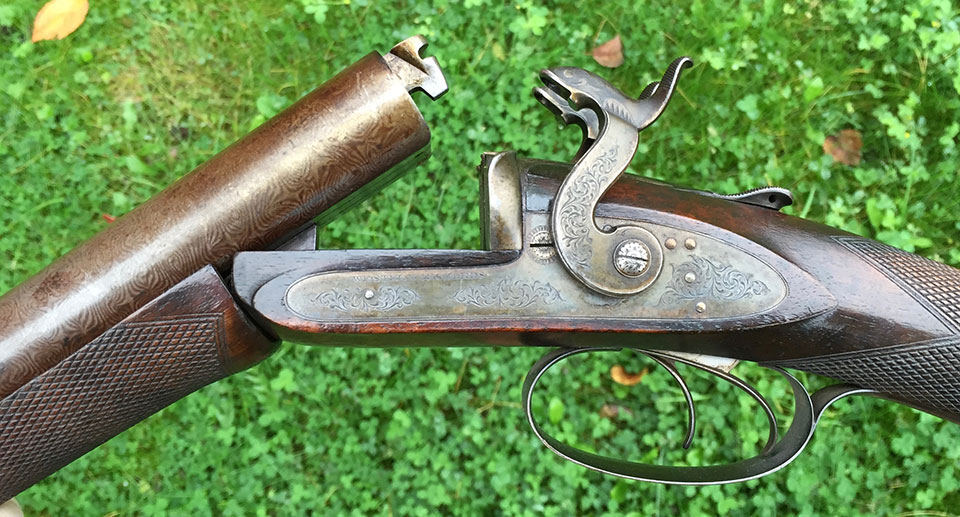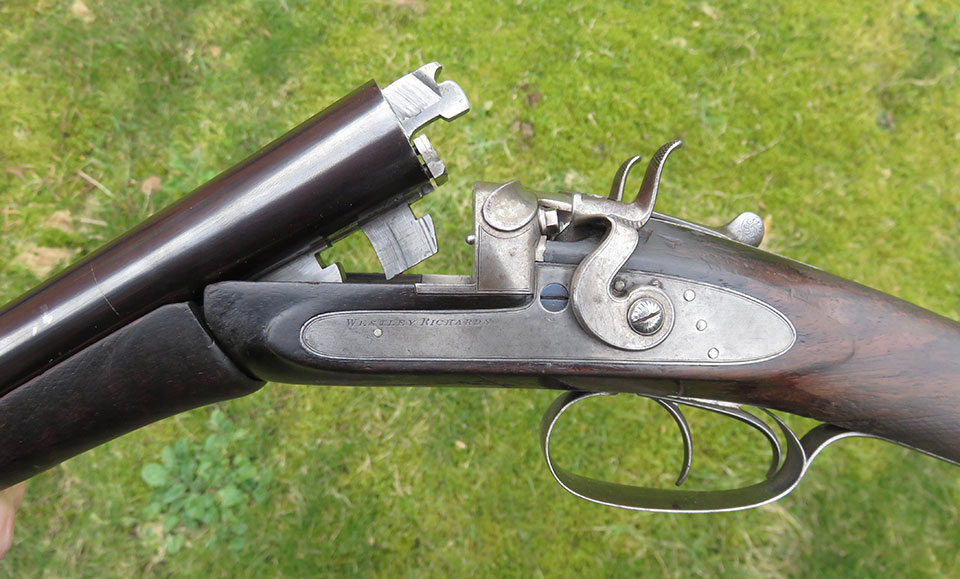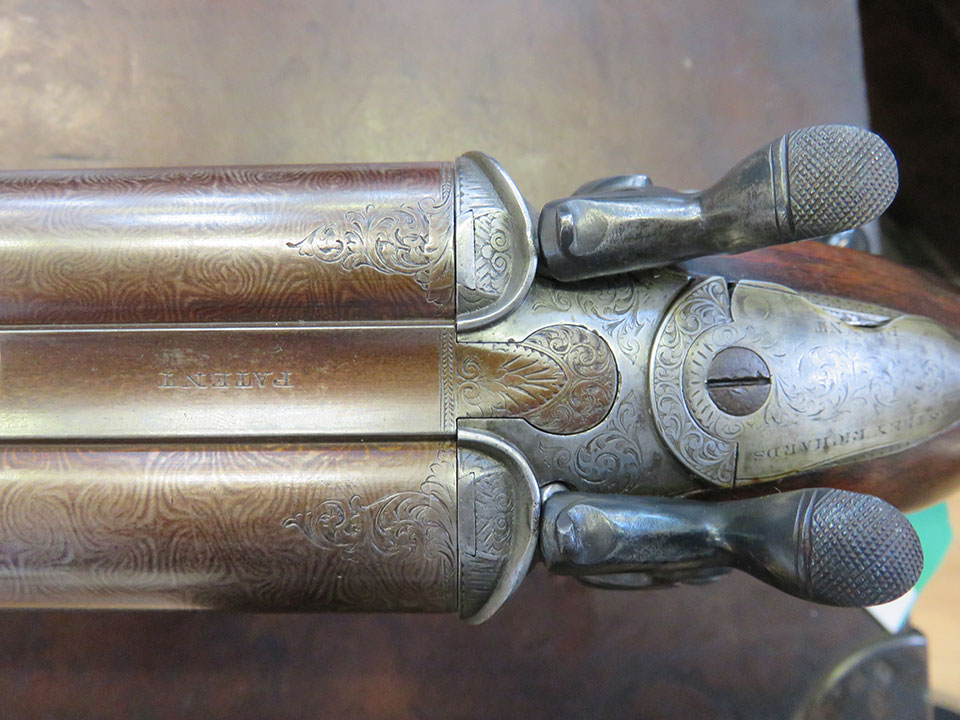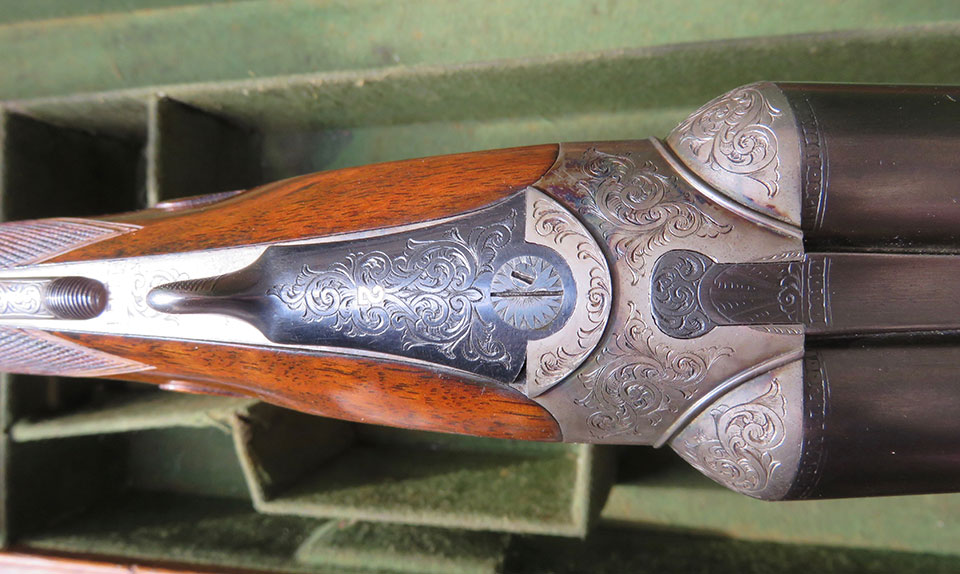The breech loader got its real introduction to England in 1851, when Lefaucheux exhibited his breech-loading pin-fire at the Great Exhibition. Legend has it that Edwin Hodges, a multi-talented ‘gunmaker to the trade’, made an adaptation of the gun for Joseph Lang.
Lang’s gun is credited as the first in Britain that successfully combined pin-fire cartridges with a forward facing, under-lever and barrels that drop in a hinge. The idea stuck and breech-loading pin-fires were to dominate for the next fifteen years.
While this step-change in technology was instigated by a London gun maker developing a continental idea, Birmingham firms, including Westley Richards, were at the forefront of perfecting new concepts and devising better operating mechanisms.
Pin-fire ammunition, though quicker than muzzle loading, was imperfect and the quest to improve upon it was quickly underway. However, the other challenge was to provide a quick, efficient and safe method of locking barrels to breech. Many sportsmen were afraid that the new breech-loaders would come apart in their faces. Others claimed no breech-loader would ever ‘shoot as hard’, as a muzzle-loader.
Among the first and most influential improvements on the rather flimsy Lefaucheux was the Westley Richards ‘doll’s head’. This is based on a projection from the breech ends of the barrels, extending from the rib. It has a rounded ‘head’ with a slot and the whole is drawn into a corresponding cut-out in the standing breech. The slot is engaged by a sliding top-bolt, preventing gravity from pulling down the barrels once the gun is closed.
Very early guns built with doll’s head rib extensions had a simple, long turning lever, which blocked the path of the doll’s head when closed. The first of these was made in 1858 as a pin-fire.
The first version of the, now familiar, system employed on Westley Richards guns features an 1862 patent sliding top-lever, rather than one that pivots. It most closely resembles the Horsley of 1871 in the way the lever is operated. When the lever is pulled back with the right thumb, it slides the locking bolt out of the slot in the doll’s head.
The second version quickly followed in 1864 and became the basis of a classic. It spans the pin-fire and centre-fire eras. In this version, the lever rotates to the side when pressed with the right thumb. This rotation operates the removal of the top-bolt from it’s slot. This is still the sole means of securing the barrels to the action. To modern eyes it seems flimsy but it works and many guns built this way are still in regular use. It was employed on both shotguns and double rifles.
The third version of the Westley Richards action retains the doll’s head with its top-bolt as an effective third bite. However, the main holding mechanism is Purdey’s double under-bolt of 1863. The combination of the Purdey bolt and the bolted doll’s head is retained to this day in the firm’s double rifles and shotguns.
The Westley Richards treble-grip bolting system was used by other firms in the wider gun trade but far less commonly than the combination of top-lever, Scott Spindle, or Greener lever-work, operating a Purdey bolt. The wider trade favoured simplicity and the doll’s head concept was often imitated in the form of similar looking devices without a third bolt or grip. Third grips became a feature of Birmingham guns, while many London makers preferred the cleaner lines of a gun without a rib extension, preferring to rely on well-made actions and a Purdey bolt alone.
Greener’s rival ‘Treble Wedge Fast’ consists of a simple vertical slot in the breech, accommodating a rib extension that drops in, drilled with a hole to accommodate a round-section bolt, as well as via the Purdey under-bolt. The wider gun trade adopted versions of this system in all grades of gun.
Some firms even adopted a version of the doll’s head without any kind of bolt. The concept persisted with designers and the doll’s head extension became a key part of the Webley & Brain screw-grip action that was so widely used throughout the gun trade in the late 1800s and early 1900s.
Westley Richards hammer guns of the 1860s bridged the development in ammunition from pin-fire to centre-fire. After Daw introduced the centre-fire to the British market in 1861, it began to gain traction. Today it is possible to find Westley Richards hammer guns, as described above, made as pin-fires or centre-fires and a number will be conversions from pin-fire to centre-fire.
Aesthetic norms for hammer guns developed alongside mechanical improvements. Early Westley Richards guns will typically be of bar-in-wood form, with most of the metal of the action covered by a veneer of wood, extending to the knuckle. The forend wood is similarly shaped, with wood enveloping the forend iron and looking somewhat like a hinge in the exoskeleton of a crustacean, hence the widely used term ‘crab joint’ to describe this style of gun.
As the 1870s progressed, hammer guns gradually lost their wood coverings and became the familiar pattern of exposed locks and actions with stocking limited to the areas behind the action, and forend wood reducing to the, now familiar, ‘splinter’ style, with an exposed iron fitting into the knuckle.
Westley Richards were early to the party when hammerless guns began to gain favour. As patentees of the Anson & Deeley action, the firm were quick to favour this simple, brilliant and reliable hammerless gun as their house style, while many other firms continued to make hammer guns and experiment with various styles of hammerless action. In the minds of the Westley Richards directors, the hammer gun era was over by the mid 1870s.
Published by Vintage Guns Ltd on




